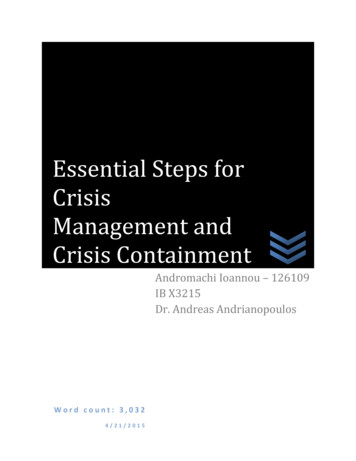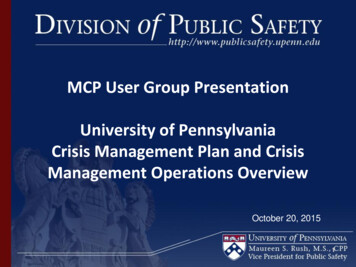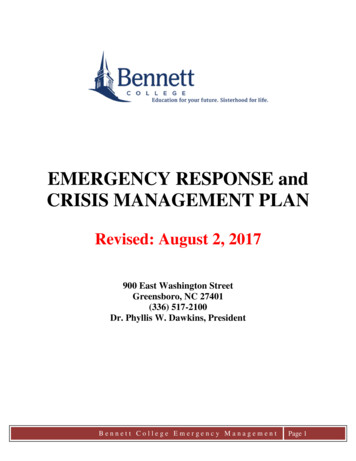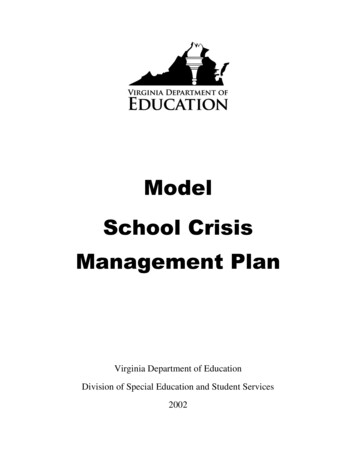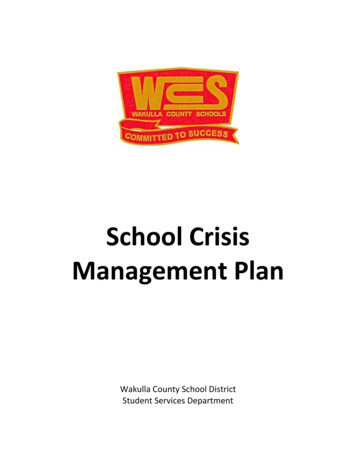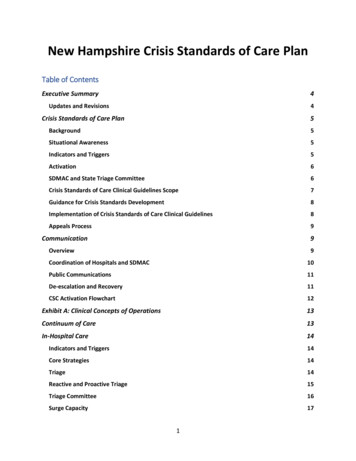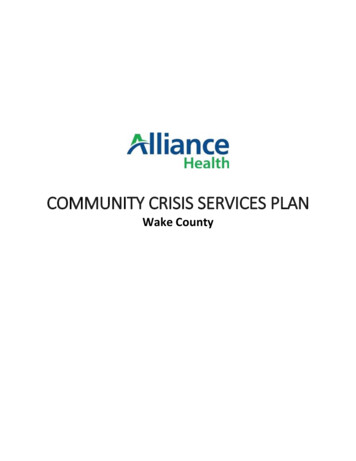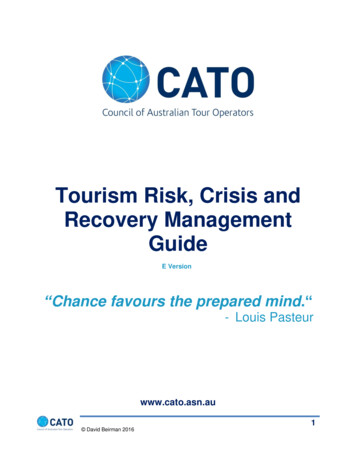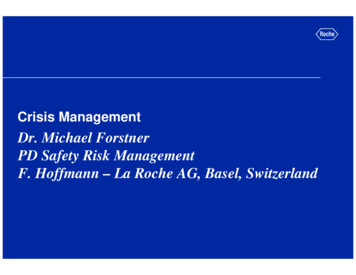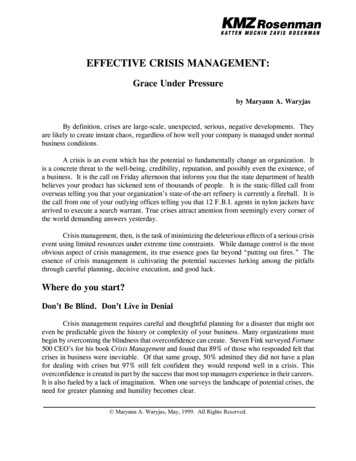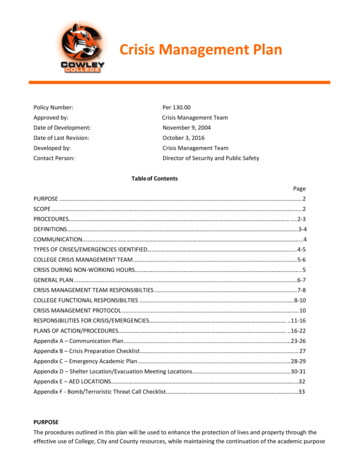
Transcription
Crisis Management PlanPolicy Number:Per 130.00Approved by:Crisis Management TeamDate of Development:November 9, 2004Date of Last Revision:October 3, 2016Developed by:Crisis Management TeamContact Person:Director of Security and Public SafetyTable of ContentsPagePURPOSE . 2SCOPE . 2PROCEDURES . 2-3DEFINITIONS .3-4COMMUNICATION .4TYPES OF CRISES/EMERGENCIES IDENTIFIED . . 4-5COLLEGE CRISIS MANAGEMENT TEAM . 5-6CRISIS DURING NON-WORKING HOURS . . 5GENERAL PLAN . 6-7CRISIS MANAGEMENT TEAM RESPONSIBILTIES . 7-8COLLEGE FUNCTIONAL RESPONSIBILTIES . 8-10CRISIS MANAGEMENT PROTOCOL . 10RESPONSIBILITIES FOR CRISIS/EMERGENCIES . 11-16PLANS OF ACTION/PROCEDURES . 16-22Appendix A – Communication Plan . 23-26Appendix B – Crisis Preparation Checklist. 27Appendix C – Emergency Academic Plan . 28-29Appendix D – Shelter Location/Evacuation Meeting Locations . 30-31Appendix E – AED LOCATIONS .32Appendix F - Bomb/Terroristic Threat Call Checklist 33PURPOSEThe procedures outlined in this plan will be used to enhance the protection of lives and property through theeffective use of College, City and County resources, while maintaining the continuation of the academic purpose
of the college. This plan is designed to assist the College community to cope with the anticipated needsgenerated by an emergency situation and to assist with communication of those events and needs. This planshall address various situations which may threaten the physical or personal safety of students, employees, thegeneral public, and/or resources of the College utilizing the National Incident Management System (NIMS) andthe Incident Command Structure (ICS), and shall meet the requirements of the Occupational Health and SafetyAdministration (OSHA).SCOPEThe College will maintain a plan specifying policy and procedures to be used in such crisis or emergencies ofwhich are a significant disruption to the general operations of the College including but not limited to: naturaldisasters (tornado, floods, earthquakes, etc.), industrial accidents, fire, any illness/injury or other medicalemergency, outbreak of disease or infection, violent crimes or behaviors, criminal activities, acts of terror war,political situations, bomb threats, or deaths, attempted or otherwise, and all other similar situations that requirethe orderly management of resources and processes to protect life and property.This procedure applies to all college departments, faculty, staff, students and/or non-College persons.PROCEDURESProcedures for Emergency Procedures and Disaster Plans shall: Protect and preserve human life and health with the utmost importance. Protect and preserve College property and other resources whenever possible consistent with theprimacy of human health and safety. Coordinate with and in cooperation with Federal, State, or local emergency management and lawenforcement agencies. Specify functional response protocols needed for staff and/or faculty to respond to emergencysituations including medical emergencies. Specify incident procedures for “A.L.I.C.E.,” “Exterior Lockdown,” “Clear the Halls,” “Evacuation,”“Reverse Evacuation,” “Off Campus Evacuation,” and “Shelter-in-Place.” Coordinate efforts of appropriate campus personnel, department, and/or resources as available andneeded. Utilize National Incident Management System (NIMS), the Incident Command System (ICS) and theOccupational Health and Safety Association’s (OSHA) regulations. Ensure that faculty and staff continue to provide and maintain an academic learning environment duringa time of crisis. Provide counseling/supportive services to those affected by any such crisis and provide assistance infamily reunification. Utilize the College’s administration to notify and consult with the College’s attorney in cases where thelegal responsibilities of the College are unclear, either prior to, during, or after an incident.The College has a policy of zero tolerance for violence. Employees who engage in any violence in the workplace,or threaten violence in the workplace, may be terminated immediately for cause. No talk of violence or jokingabout violence will be tolerated.DefinitionsActive Killer: An individual actively engaged in killing or attempting to kill people in a confined or populated area.
Bomb Threats: A bomb threat is any threat, verbal or written; to detonate an explosive or incendiary device withthe intention of causing property damage, death, or injuries, whether or not such a device actually exists.College Grounds: College grounds are property owned, maintained and/or operated by the College. This includesinterior or exterior of any and all buildings and/or structures, sporting facilities, parking lots, streets, sidewalks,and thoroughfares.College-Sponsored Events: College-sponsored activities or programs include all activities funded or organized inany way through the CollegeCrisis Management Plan: The Crisis Management Plan is a plan to address various situations that might threatenthe physical safety of students, employees, the general public and/or resources of the College.Crisis Management Team: The Crisis Management Team is designated individuals with specified tasks and/orresponsibilities which must be able to respond and react as a team in an emergency or crisis situation. This teamis created under the authority of the President of the College and the authority to activate the CrisisManagement Team is delegated and granted to each team member.Environmental or Natural Disasters: Environmental or natural disasters are mishaps, accidents, or events arehappenings that are often suddenly and unexpected which are caused by carelessness, negligence, badjudgment, or the like, or by natural forces as a tornado, earthquake, flood or the like.Incident Command System (ICS): ICS is a national program administered by the Federal Emergency ManagementAgency which provides a standardized, on-scene, all-hazards incident management approach that allows for theintegration of facilities, personnel, procedures, and communications operating within a common organizationaljurisdiction; enables a coordinated response among various jurisdictions and functional agencies, both publicand private; and establishes common processes for planning and managing resources.Medical Emergencies: Medical emergencies are injury or illness that is acute and poses an immediate risk to aperson’s life or long term health. This would also include a pandemic outbreak or any other health relatedhazard with a sudden, violent, or spontaneous occurrence that could be detrimental to the health of multiplepersons.National Incident Command System (NIMS): NIMS is a national program administered by the Federal EmergencyManagement Agency (FEMA) which identifies concepts and principles that answer how to manage emergenciesfrom preparedness to recovery regardless of their cause, size, location, or complexity.Off-Campus Incidents or Accidents: Off-campus incidents or accidents are any undesirable or unfortunate eventthat happens unexpectedly that occurs unintentionally and/or usually results in harm, injury, damage, or lossduring any part of an off-campus activity or event which is college-sponsored or would have a significant impacton the general operation of the College.Political Situations: Political situations are occurrences such as demonstrations, assemblies, rallies, marches orparades, unauthorized walkouts, or any equivalent action or behavior which is disruptive or has a negativeimpact on the general operation of the College and has the intention of persuading a particular point-of-view,usually political in nature.Violence: Violence is the exercise or an instance of physical force, usually effecting or intended to effect injury,destruction, to inflict harm upon or violate another, or an unjust, unwarranted, or unlawful display or exertionof force, as against rights or laws, especially such as tends to overawe or intimidate another individual. Thisincludes physically harming another, shoving, pushing, bullying, harassing, intimidating, coercing, brandishingweapons, threatening or talk of engagement in such actions or behaviors, or any other like form of unruly orinjurious action or behavior. Employees who engage in who engage in workplace violence, or threaten violencein the workplace, shall be terminated immediately for cause. It is the intent of this plan to ensure that everyoneassociated with the College, including students and employees, never feels threatened by any other person’sactions or conduct.
Violent Crimes or Behaviors: Violent crime or behaviors are any action or behavior that is harmful (physically,mentally, socially, or otherwise) to either a person, the College or the community and is a violation a local, State,or Federal law.COMMUNICATIONThe following communication principles apply during a College crisis:After receiving a report or discovering a crisis has or is about to occur, initial communications will be made viathe Emergency Intercom Response System (E.R.I.S.) to all facilities, email distribution to all staff, faculty, andstudents, text messaging service (BlackBoard Connect) to accounts in the College’s directory and StudentInformation System as well an announcement on the College’s website and social media outlets. Appropriateinformation shall be provided routinely to College employees, students and public to facilitate their cooperationin a potential crisis. Any further updates or instruction shall also be provided these same means ofcommunication during or post-occurrence of a crisis.Further communication shall be from the President or his/her designee with respect to crises affecting theCollege.The Crisis Management Team shall inform the President and the Clerk of the Board of any crisis that may or hasoccurred, or that is threatening life, health, or College property, and give periodic status reports as informationis available. The Clerk of the Board shall, in turn, keep members of the Board of Trustees properly informed.Supporting staff and first responders for a crisis shall communicate via RF Radio’s as a more effective andreliable means of communication during a crisis or at times when phone systems may become overloaded ormodes of communication via internet may not be reliable or available.The Director of Security and Public Safety shall be the contact person for adaptations or revisions to this policy.TYPES OF CRISES/EMERGENCIES IDENTIFIED1. Medical Emergency – epidemic, poisoning, etc.2. Terroristic Threat – active killer, etc. (imminent threat to life safety for college community)3. Violent Crime or Behavior – robbery, criminal, shooting, fights, assaults, personal injury (existing orpotential), etc. – in progress4. Discovery of Violent Crimes (post occurrence)5. Political Situations – riots, demonstrations, etc.6. Off-Campus Incidents/Accidents Involving Students, Faculty and/or Staff7. Environmental/Natural Disasters – fires, flood, tornadoes, earthquakes, explosions, etc.8. Bomb Threats or any terroristic threat received by phone, etc.Loss of Life or any Medical-Related Death Threat – Heart Attacks, Suicides (including suicide attempts orthoughts), Homicides (Intentional or Unintentional), Accidental Overdoses, Significant Life ThreateningInjuries, Unattended Deaths, etc.9. Industrial/Hazardous Materials Spills/LeaksCOLLEGE CRISIS MANAGEMENT TEAMThe College Crisis Management Team is created under the authority of the President of Cowley College.Authority to activate the Crisis Management Team is delegated and granted to each team member.The College Crisis Management Team must be available to respond and react as a team in emergency or crisissituations. The team is required to meet annually to review the plan and update information, and shall beconvened by the Director of Campus Security and Public Safety. A written report will be produced by theDirector of Campus Security and Public Safety after each review. Revisions to the plan will be recorded at the
conclusion of this document.The College Crisis Management Team will consist of the following roles and responsibilities: Incident commander – Establish immediate priorities and stabilize the incident by ensuring life safety.Establish and monitor incident organization and approve written or oral Incident Action Plan (IAP). Information Officer – Develop and release information about the incident to media, incident personneland other appropriat
03.10.2016 · Crisis Management Plan: The Crisis Management Plan is a plan to address various situations that might threaten the physical safety of students, employees, the general public and/or resources of the College. Crisis Management Team: The Crisis Management Team is designated individuals with specified tasks and/orFile Size: 567KBPage Count: 32
